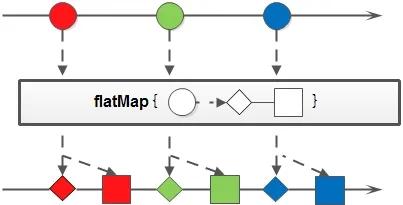1、stream概述
java 8 Stream 是一个非常成功的版本,这个版本新增的stream 配合 Lambda,给我操作集合带来了极大的便利。
那么 什么是stream?
stream 将要处理的元素集合看做一种流,在流的过程中,借助Stream API对流中的元素进行操作,比如:筛选、排序、聚合。。。
Stream可以由数组或集合创建,对流的操作分为两种:
- 中间操作,每次返回一个新的流,可以有多个。
- 终端操作,每个流只能进行一次终端操作,终端操作结束后流无法再次操作。终端操作会产生一个新的集合或者值。
另外,Stream有几个特性:
2. Stream 的创建
- stream不存储数据,而是按照特定的规则数据进行计算,一般会输出结果
- stream不改变数据源,通常会产生一个新的集合或者一个值
- stream具有延迟执行的特性,只有调用终端操作时,中间操作才会执行。
Stream可以通过集合数组创建。
1、通过 java.util.Collection.stream() 方法用集合创建流
List<String> list = Arrays.asList("a","b","c"); //创建一个顺序流 Stream<String> stream = list.stream(); //创建一个并行流 Stream<String> parallelStream = list.parallelStream();2、使用java.util.Arrays.stream(T[] array)方法用数组创建流
int[] array = {1,2,3,4,5}; IntStream stream1 = Arrays.stream(array);3、使用Stream的静态方法:of()、iterate()、generate()
//方法3 Stream<integer> integerStream = Stream.of(1, 2, 3, 4, 5); Stream<Integer> limit = Stream.iterate(0, x -> x 3).limit(4); limit.foreach(System.out::println); Stream<Double> limit1 = Stream.generate(Math::random).limit(4); limit1.forEach(System.out::println);stream和parallelStream的简单区分: stream是顺序流,由主线程按顺序对流执行操作,而parallelStream是并行流,内部以多线程方式对流进行操作,但前提是流中的数据处理没有顺序要求。例如筛选集合中的偶数。
如果流中的数据量足够大,并行流可以加快处理速度。
除了直接创建并行流,还可以通过parallel()把顺序流转变成并行流。
3. Stream 的使用
Optional<Integer> findFirst = list.stream().parallel().filter(x->x>6).findFirst();
在使用 stream 之前,先理解一个概念:Optional 。
Optional 是一个可以为null的容器,如果值存在则isPresent()会返回true,调用get()方法会返回该对象。更
详细说明请见:Java 8 Optional 类详解
将用 20 个案例将 Stream 的使用整得明明白白,只要跟着敲一遍代码,就能很好地掌握。
3.1. 案例使用的员工类3.2. 遍历/匹配(foreach/find/match)
@Data @AllArgsConstructor public class Person { private String name; private int salary; private int age; private String sex; } List<Person> personList = new ArrayList<Person>(); personList.add(new Person("tom", 9000, 40, "male")); personList.add(new Person("simon", 8000, 30, "male")); personList.add(new Person("candy", 5000, 20, "female")); personList.add(new Person("seth", 3000, 10, "male")); personList.add(new Person("lily", 1000, 8, "female"));Stream也是支持类似集合的遍历和匹配元素的,只是Stream中的元素是以Optional类型存在的。Stream的遍历、匹配非常简单。
List<Integer> integers = Arrays.asList(7, 6, 5, 4, 3, 2, 1); //遍历输出符合条件的元素 Integers.stream().filter(x->x>6).forEach(System.out::println); //匹配第一个 Optional<Integer> first = integers.stream().filter(x -> x > 6).findFirst(); //匹配任意 Optional<Integer> any = integers.parallelStream().filter(x -> x > 6).findAny(); // 是否包含符合特定条件的元素 boolean b = integers.stream().anyMatch(x -> x > 6); System.out.println("匹配第一个:" first.get()); System.out.println("匹配任意一个" any.get()); System.out.println("是否存在大于6:" b);注意: 返回的对象Optional ,需要先判断是否存在值,否则会抛出异常。
3.3. 筛选(filter)筛选,是按照一定的规则校验流中的元素,将符合条件的元素提取到新的流中的操作。
案例一:筛选出**Integer集合中大于 7 的元素,并打印出来**
List<Integer> integers1 = Arrays.asList(9, 8, 7, 6, 5, 4, 3, 2, 1); // 输出集合中大于7的数并打印出来 integers1.stream().filter(x -> x > 7).forEach(System.out::println);预期:8 9
案例二:筛选员工中工资高于 8000 的人,并形成新的集合。 形成新集合依赖collect(收集),后文有详细介绍。
//筛选员工中工资大于5000的并形成新的集合 List<String> collect = personList.stream().filter(x -> x.getSalary() > 5000).map(Person::getName).collect(Collectors.toList()); System.out.println(collect);预期:[tom, simon]
3.4. 聚合(max/min/count)max、min、count这些字眼你一定不陌生,没错,在 mysql 中我们常用它们进行数据统计。Java stream 中也引入了这些概念和用法,极大地方便了我们对集合、数组的数据统计工作。
案例一:获取**String集合中最长的元素。**
//获取集合中最长的元素 List<String> list1 = Arrays.asList("admin", "adm", "admi", "dddddd", "aaaaa", "mmmmmmm"); Optional<String> max = list1.stream().max(Comparator.comparing(String::length)); System.out.println(max.get());案例三:获取员工工资最高的人。
//案例三:获取员工工资最高的人。 Optional<Person> max1 = personList.stream().max(Comparator.comparingInt(Person::getSalary)); System.out.println(max1.get().getSalary());案例四:计算**Integer集合中大于 6 的元素的个数。**
3.5. 映射(map/flatMap)
//案例四:计算integers1集合中大于 6 的元素的个数。 long count = integers1.stream().filter(x -> x > 6).count(); System.out.println(count);映射,可以将一个流的元素按照一定的映射规则映射到另一个流中。分为map和flatMap:
- map:接收一个函数作为参数,该函数会被应用到每个元素上,并将其映射成一个新的元素。
- flatMap:接收一个函数作为参数,将流中的每个值都换成另一个流,然后把所有流连接成一个流。
案例一:英文字符串数组的元素全部改为大写。整数数组每个元素 3。
//案例一:英文字符串数组的元素全部改为大写。整数数组每个元素 3。 String[] str = {"aaaa","bbbbbb","ccccc","dddddddd"}; List<String> collect1 = Arrays.stream(str).map(String::toUpperCase).collect(Collectors.toList()); System.out.println(collect1); List<Integer> integers2 = Arrays.asList(1, 3, 5, 7, 9); List<Integer> collect2 = integers2.stream().map(x -> x 3).collect(Collectors.toList()); System.out.println(collect2);案例二:将员工的薪资全部增加 1000。
//案例二:将员工的薪资全部增加 1000。 List<Person> collect3 = personList.stream().map(person -> { Person newP = new Person(person.getName(), person.getSalary() 10000, person.getAge(), person.getSex()); return newP; }).collect(Collectors.toList()); System.out.println(collect3); //改变原集合 List<Person> collect4 = personList.stream().map(person -> { person.setSalary(person.getSalary() 10000) return person; }).collect(Collectors.toList()); System.out.println(collect4);案例三:将两个字符数组合并成一个新的字符数组。
3.6. 归约(reduce)
List<String> list = Arrays.asList("m,k,l,a", "1,3,5,7"); List<String> listNew = list.stream().flatMap(s -> { // 将每个元素转换成一个stream String[] split = s.split(","); Stream<String> s2 = Arrays.stream(split); return s2; }).collect(Collectors.toList()); System.out.println("处理前的集合:" list); System.out.println("处理后的集合:" listNew);归约,也称缩减,顾名思义,是把一个流缩减成一个值,能实现对集合求和、求乘积和求最值操作。
案例一:求**Integer集合的元素之和、乘积和最大值。**
List<Integer> list = Arrays.asList(1, 3, 2, 8, 11, 4); // 求和方式1 Optional<Integer> sum = list.stream().reduce((x, y) -> x y); // 求和方式2 Optional<Integer> sum2 = list.stream().reduce(Integer::sum); // 求和方式3 Integer sum3 = list.stream().reduce(0, Integer::sum); // 求乘积 Optional<Integer> product = list.stream().reduce((x, y) -> x * y); // 求最大值方式1 Optional<Integer> max = list.stream().reduce((x, y) -> x > y ? x : y); // 求最大值写法2 Integer max2 = list.stream().reduce(1, Integer::max); System.out.println("list求和:" sum.get() "," sum2.get() "," sum3); System.out.println("list求积:" product.get()); System.out.println("list求和:" max.get() "," max2);案例二:求所有员工的工资之和和最高工资。
3.7. 收集(collect)
// 求工资之和方式1: Optional<Integer> sumSalary = personList.stream().map(Person::getSalary).reduce(Integer::sum); // 求工资之和方式2: Integer sumSalary2 = personList.stream().reduce(0, (sum, p) -> sum = p.getSalary(), (sum1, sum2) -> sum1 sum2); // 求工资之和方式3: Integer sumSalary3 = personList.stream().reduce(0, (sum, p) -> sum = p.getSalary(), Integer::sum); // 求最高工资方式1: Integer maxSalary = personList.stream().reduce(0, (max, p) -> max > p.getSalary() ? max : p.getSalary(), Integer::max); // 求最高工资方式2: Integer maxSalary2 = personList.stream().reduce(0, (max, p) -> max > p.getSalary() ? max : p.getSalary(), (max1, max2) -> max1 > max2 ? max1 : max2); System.out.println("工资之和:" sumSalary.get() "," sumSalary2 "," sumSalary3); System.out.println("最高工资:" maxSalary "," maxSalary2);collect,收集,可以说是内容最繁多、功能最丰富的部分了。从字面上去理解,就是把一个流收集起来,最终可以是收集成一个值也可以收集成一个新的集合。
collect主要依赖java.util.stream.Collectors类内置的静态方法。
3.7.1 归集(toList/toSet/toMap)因为流不存储数据,那么在流中的数据完成处理后,需要将流中的数据重新归集到新的集合里。toList、toSet和toMap比较常用,另外还有toCollection、toConcurrentMap等复杂一些的用法。
下面用一个案例演示toList、toSet和toMap:
3.7.2 统计(count/averaging)
List<Integer> list = Arrays.asList(1, 6, 3, 4, 6, 7, 9, 6, 20); List<Integer> listNew = list.stream().filter(x -> x % 2 == 0).collect(Collectors.toList()); Set<Integer> set = list.stream().filter(x -> x % 2 == 0).collect(Collectors.toSet()); List<Person> personList = new ArrayList<Person>(); personList.add(new Person("Tom", 8900, 23, "male", "New York")); personList.add(new Person("Jack", 7000, 25, "male", "Washington")); personList.add(new Person("Lily", 7800, 21, "female", "Washington")); personList.add(new Person("Anni", 8200, 24, "female", "New York")); Map<?, Person> map = personList.stream().filter(p -> p.getSalary() > 8000) .collect(Collectors.toMap(Person::getName, p -> p)); System.out.println("toList:" listNew); System.out.println("toSet:" set); System.out.println("toMap:" map);Collectors提供了一系列用于数据统计的静态方法:
- 计数:count
- 平均值:averagingInt、averagingLong、averagingDouble
- 最值:maxBy、minBy
- 求和:summingInt、summingLong、summingDouble
- 统计以上所有:summarizingInt、summarizingLong、summarizingDouble
案例:统计员工人数、平均工资、工资总额、最高工资。
3.7.3 分组(partitioningBy/groupingBy)
List<Person> personList = new ArrayList<Person>(); personList.add(new Person("Tom", 8900, 23, "male", "New York")); personList.add(new Person("Jack", 7000, 25, "male", "Washington")); personList.add(new Person("Lily", 7800, 21, "female", "Washington")); // 求总数 Long count = personList.stream().collect(Collectors.counting()); // 求平均工资 Double average = personList.stream().collect(Collectors.averagingDouble(Person::getSalary)); // 求最高工资 Optional<Integer> max = personList.stream().map(Person::getSalary).collect(Collectors.maxBy(Integer::compare)); // 求工资之和 Integer sum = personList.stream().collect(Collectors.summingInt(Person::getSalary)); // 一次性统计所有信息 DoubleSummaryStatistics collect = personList.stream().collect(Collectors.summarizingDouble(Person::getSalary)); System.out.println("员工总数:" count); System.out.println("员工平均工资:" average); System.out.println("员工工资总和:" sum); System.out.println("员工工资所有统计:" collect);
- 分区:将stream按条件分为两个Map,比如员工按薪资是否高于 8000 分为两部分。
- 分组:将集合分为多个 Map,比如员工按性别分组。有单级分组和多级分组。
案例:将员工按薪资是否高于 8000 分为两部分;将员工按性别和地区分组
3.7.4 接合(joining)
// 将员工按薪资是否高于8000分组 Map<Boolean, List<Person>> part = personList.stream().collect(Collectors.partitioningBy(x -> x.getSalary() > 8000)); // 将员工按性别分组 Map<String, List<Person>> group = personList.stream().collect(Collectors.groupingBy(Person::getSex)); // 将员工先按性别分组,再按地区分组 Map<String, Map<String, List<Person>>> group2 = personList.stream().collect(Collectors.groupingBy(Person::getSex, Collectors.groupingBy(Person::getArea))); System.out.println("员工按薪资是否大于8000分组情况:" part); System.out.println("员工按性别分组情况:" group); System.out.println("员工按性别、地区:" group2);3.7.5 归约(reducing)
List<Person> personList = new ArrayList<Person>(); personList.add(new Person("Tom", 8900, 23, "male", "New York")); personList.add(new Person("Jack", 7000, 25, "male", "Washington")); personList.add(new Person("Lily", 7800, 21, "female", "Washington")); String names = personList.stream().map(p -> p.getName()).collect(Collectors.joining(",")); System.out.println("所有员工的姓名:" names); List<String> list = Arrays.asList("A", "B", "C"); String string = list.stream().collect(Collectors.joining("-")); System.out.println("拼接后的字符串:" string);3.8. 排序(sorted)
// 每个员工减去起征点后的薪资之和(这个例子并不严谨,但一时没想到好的例子) Integer sum = personList.stream().collect(Collectors.reducing(0, Person::getSalary, (i, j) -> (i j - 5000))); System.out.println("员工扣税薪资总和:" sum);sorted,中间操作。有两种排序:
- sorted():自然排序,流中元素需实现 Comparable 接口
- sorted(Comparator com):Comparator 排序器自定义排序
案例:将员工按工资由高到低(工资一样则按年龄由大到小)排序
3.9. 提取/组合
List<Person> personList = new ArrayList<Person>(); personList.add(new Person("Sherry", 9000, 24, "female", "New York")); personList.add(new Person("Tom", 8900, 22, "male", "Washington")); personList.add(new Person("Jack", 9000, 25, "male", "Washington")); personList.add(new Person("Lily", 8800, 26, "male", "New York")); personList.add(new Person("Alisa", 9000, 26, "female", "New York")); // 按工资升序排序(自然排序) List<String> newList = personList.stream().sorted(Comparator.comparing(Person::getSalary)).map(Person::getName) .collect(Collectors.toList()); // 按工资倒序排序 List<String> newList2 = personList.stream().sorted(Comparator.comparing(Person::getSalary).reversed()) .map(Person::getName).collect(Collectors.toList()); // 先按工资再按年龄升序排序 List<String> newList3 = personList.stream() .sorted(Comparator.comparing(Person::getSalary).thenComparing(Person::getAge)).map(Person::getName) .collect(Collectors.toList()); // 先按工资再按年龄自定义排序(降序) List<String> newList4 = personList.stream().sorted((p1, p2) -> { if (p1.getSalary() == p2.getSalary()) { return p2.getAge() - p1.getAge(); } else { return p2.getSalary() - p1.getSalary(); } }).map(Person::getName).collect(Collectors.toList()); System.out.println("按工资升序排序:" newList); System.out.println("按工资降序排序:" newList2); System.out.println("先按工资再按年龄升序排序:" newList3); System.out.println("先按工资再按年龄自定义降序排序:" newList4);
String[] arr1 = { "a", "b", "c", "d" }; String[] arr2 = { "d", "e", "f", "g" }; Stream<String> stream1 = Stream.of(arr1); Stream<String> stream2 = Stream.of(arr2); // concat:合并两个流 distinct:去重 List<String> newList = Stream.concat(stream1, stream2).distinct().collect(Collectors.toList()); // limit:限制从流中获得前n个数据 List<Integer> collect = Stream.iterate(1, x -> x 2).limit(10).collect(Collectors.toList()); // skip:跳过前n个数据 List<Integer> collect2 = Stream.iterate(1, x -> x 2).skip(1).limit(5).collect(Collectors.toList()); System.out.println("流合并:" newList); System.out.println("limit:" collect); System.out.println("skip:" collect2);终于完成了,你可以细细品味了。
,















